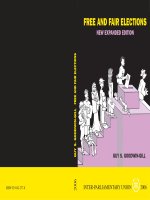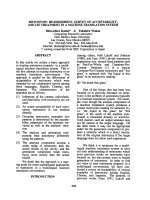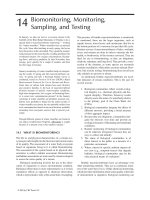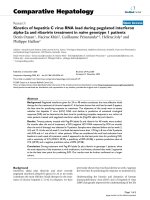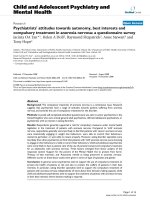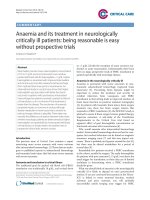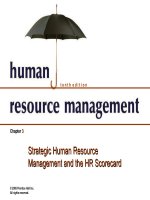Dessler ch 14 ethics, justice and fair treatment in HR manag
Bạn đang xem bản rút gọn của tài liệu. Xem và tải ngay bản đầy đủ của tài liệu tại đây (557.85 KB, 59 trang )
Gary Dessler
tenth edition
Chapter 14
Part 5 Employee Relations
Ethics, Justice, and Fair Treatment
in HR Management
© 2005 Prentice Hall Inc.
All rights reserved.
PowerPoint Presentation by Charlie Cook
The University of West Alabama
After studying this chapter,
you should be able to:
1.
Explain what is meant by ethical behavior at work.
2.
Discuss important factors that shape ethical
behavior at work.
3.
Describe at least four specific ways in which HR
management can influence ethical behavior at
work.
4.
Employ fair disciplinary practices.
5.
List at least four important factors in managing
dismissals effectively.
© 2005 Prentice Hall Inc. All rights reserved.
14–2
14–2
Ethics and Fair Treatment at Work
Ethics
– The principles of conduct governing an individual
or a group; specifically, the standards you use to
decide what your conduct should be.
– Ethical behavior depends on the person’s frame of
reference.
© 2005 Prentice Hall Inc.
All rights reserved.
14–
3
The Wall Street Journal Workplace-Ethics Quiz
© 2005 Prentice Hall Inc.
All rights reserved.
Source: Wall Street Journal, October 21, 1999, pp. B1–B4; Ethics Officer Association, Belmont, MA; Ethics Leadership
Group, Wilmette, IL; surveys sampled a cross-section of workers at large companies and nationwide.
Figure 14–1
14–4
Factors affecting ethical decisions
Normative judgments
– Judging something as good or bad, right or
wrong, better or worse.
Moral standards (Morality)
– Society’s accepted standards for behaviors that
have serious consequences to its well-being.
• Behaviors that cannot be established or changed by
decisions of authoritative bodies.
• Behaviors that override self-interest.
© 2005 Prentice Hall Inc.
All rights reserved.
14–5
Ethics and Fair Treatment at Work
(cont’d)
Ethics and the law
–
–
–
–
An
An
An
An
behavior
behavior
behavior
behavior
may
may
may
may
be
be
be
be
© 2005 Prentice Hall Inc.
All rights reserved.
legal but unethical.
illegal but ethical.
both legal and ethical.
both illegal and unethical.
14–
6
Ethics, Fair Treatment, and Justice
Distributive justice
– The fairness and justice of a decision’s result.
Procedural justice
– The fairness of the process by which the decision
was reached.
Interactional (interpersonal) justice
– The manner in which managers conduct their
interpersonal dealings with employees.
© 2005 Prentice Hall Inc.
All rights reserved.
14–7
Perceptions of Fair Interpersonal Treatment Scale
© 2005 Prentice Hall Inc.
All rights reserved.
Sources: Michelle A. Donovan et al., “The Perceptions of Their Interpersonal Treatment Scale: Development and Validation of a
Measure of Interpersonal Treatment in the Workplace,” Journal of Applied Psychology 83, no. 5 (1998), p. 692. Copyright © 1997
by Michelle A. Donovan, Fritz Drasgow, and Liberty J. Munson at the University of Illinois at Urbana-Champaign. All rights reserved.
Figure 14–2
14–8
What Shapes Ethical Behavior at Work?
Individual factors
Organizational factors
The boss’s influence
Ethics policies and codes
The organization’s culture
© 2005 Prentice Hall Inc.
All rights reserved.
14–9
Employees and Ethical Dilemmas
Questions employees should ask when faced
with ethical dilemmas:
–
–
–
–
–
–
–
Is the action legal?
Is it right?
Who will be affected?
Does it fit the company’s values?
How will it “feel” afterwards?
How will it look in the newspaper?
Will it reflect poorly on the company?
© 2005 Prentice Hall Inc.
All rights reserved.
14–
10
Principal Causes of Ethical Compromises
Note: 1 is high, 9 is low.
© 2005 Prentice Hall Inc.
All rights reserved.
Sources: O.C. Ferrell and John Fraedrich, Business Ethics, 3rd ed. (New York: Houghton Mifflin, 1997), p. 28;
adapted from Rebecca Goodell, Ethics in American Business: Policies, Programs, and Perceptions (1994), p. 54.
Permission provided courtesy of the Ethics Resource Center, 1120 6th Street NW, Washington, DC: 20005.
14–
11
Table 14–1
What Is Organizational Culture?
Organization culture
– The characteristic values, traditions, and
behaviors a company’s employees share.
How is culture is revealed?
– Ceremonial events
– Written rules and spoken commands.
– Office layout
– Organizational structure
– Dress codes
– Cultural symbols and behaviors
– Figureheads
© 2005 Prentice Hall Inc.
All rights reserved.
14–
12
The Manager’s Role in Creating Culture
Clarify expectations for values to be followed.
Use signs and symbols to signal the
importance of values.
Provide physical (the firm’s rewards) support
for values.
Use stories to illustrate values.
Organize rites and ceremonies reinforcing
values
© 2005 Prentice Hall Inc.
All rights reserved.
14–
13
HR’s Role in Fostering Ethics and Fair
Treatment
Why treat employees fairly?
– “They’re not employees, they’re people”
• Management guru Peter Drucker
– Avoidance of employee litigation
– Enhanced employee commitment
– Enhanced satisfaction with the organization, with
jobs, and with leaders
– Increased organizational citizenship behaviors
© 2005 Prentice Hall Inc.
All rights reserved.
14–
14
U.S.DataTrust
U.S.DataTrust
© 2005 Prentice Hall Inc.
All rights reserved.
Source: All contents copyright
© 2002–2004 U.S. Data Trust
Corporation. All rights reserved.
Privacy policy. Your use of this
site indicates your agreement to
be bound by the Terms of Use
Site Map.
14–
15
Figure 14–4
HR Ethics Activities
Staffing and selection
– Fostering the perception of fairness in the
processes of recruitment and hiring of people.
• Formal procedures
• Interpersonal treatment
• Providing explanation
Training
– How to recognize ethical dilemmas.
– How to use ethical frameworks (such as codes of
conduct) to resolve problems.
– How to use HR functions (such as interviews and
disciplinary
practices)
© 2005
Prentice Hall
Inc. in ethical ways.
14–
All rights reserved.
16
HR Ethics Activities (cont’d)
Performance appraisal
– Appraisals that make it clear the company adheres
to high ethical standards by measuring and
rewarding employees who follow those standards.
Reward and disciplinary systems
– The organization swiftly and harshly punishes
unethical conduct.
Workplace aggression and violence
– Taking care that HR actions do not foster
perceptions of inequities that translate into
dysfunctional behaviors by employees.
© 2005 Prentice Hall Inc.
All rights reserved.
14–
17
The Role of Training
in Ethics
© 2005 Prentice Hall Inc.
All rights reserved.
14–
18
Figure 14–5
The Role of Training
in Ethics (cont’d)
© 2005 Prentice Hall Inc.
All rights reserved.
14–
19
Figure 14–5 (cont’d)
Building Two-Way Communications
Perceptions of fair treatment depend on:
– Engagement—involving individuals in the
decisions that affect them by asking for their input
and allowing them to refute the merits of others’
ideas and assumptions
– Explanation—ensuring that everyone involved
and affected understands why final decisions are
made and the thinking that underlies the decisions
– Expectation clarity—making sure everyone
knows up front by what standards they will be
judged and the penalties for failure.
© 2005 Prentice Hall Inc.
All rights reserved.
14–
20
Employee Discipline and Privacy
Basis for a fair and just discipline process
– Clear rules and regulations
• Define workplace issues
• Inform employees
– A system of progressive penalties
• The range and severity of the penalty is a function of the
offense and number of occurrences.
– An appeals process
• The right of the employee to grieve the decision helps to
ensure that supervisors mete out discipline fairly and
equitably.
© 2005 Prentice Hall Inc.
All rights reserved.
14–
21
Disciplining an Employee
Does the facts support the charge of employee wrongdoing?
Were the employee’s due process rights protected?
Was the employee warned of disciplinary consequences?
Was a rule violated and was it “reasonably related” to the
efficient and safe operation of the work environment?
Was the matter fairly and adequately investigated before
administering discipline?
Did the investigation produce substantial evidence of
misconduct?
Have rules, orders, or penalties been applied evenhandedly?
Is the penalty reasonably related to the misconduct and to the
employee’s past work history?
Did the employee have the right to counsel?
Did anger, hearsay, or personal impression affect the decision?
© 2005 Prentice Hall Inc.
All rights reserved.
14–
22
Disciplinary
Action Form I
© 2005 Prentice Hall Inc.
All rights reserved.
Source: Reprinted with permission
of the publisher, HRNext.com.
Copyright HRNext.com, 2003.
14–
23
Figure 14–6
Employee
Grievance
Form
© 2005 Prentice Hall Inc.
Source: NC State University. Used with permission.
All rights reserved.
14–
24
Figure 14–6
Formal Disciplinary Appeals Processes
FedEx’s guaranteed fair treatment multi-step
program
– Step 1: Management review
– Step 2: Officer complaint
– Step 3: Executive appeals review
© 2005 Prentice Hall Inc.
All rights reserved.
14–
25

